Overview
Product Rebates are financial incentives offered by sellers that can be used as a discount to a customer or as a reduction of the product cost when purchasing from a vendor. Thus, by effectively lowering the net cost, the rebate makes the product more attractive to potential buyers.
In Sellercloud, you can apply:
- Price-Based Rebates: Reduce Product Prices on integrated channels. This type of rebate changes the product’s price on integrated channels. The price sent to the channel will be the standard price for the channel minus the rebate amount.
- For example, if the Amazon Price is $99, and you have a price-based Rebate of $10, Sellercloud will update the product’s price on Amazon to $89.
- Cost-Based Rebates: Reduce the product costs in your Order Profit and Loss by a fixed amount or a percentage of the product’s Site Cost. You can apply cost-based rebates per product or per vendor. These rebates are reflected in the orders’ Profit & Loss tab:
- Profit and Loss (Estimated) panel: Rebates and Order Cost
- Order Profit Detail panel: Final Cost, Profit, and Profit %
Prerequisites
To be able to use the rebates functionality, enable these Client Settings:
- Enable Rebate Based Discounts For Channels – Enable price-based rebates for products on integrated channels.
- Include Rebate in P&L for Orders – Include cost-based rebates in the Order P&L calculation. With this setting enabled, you can also enable the setting below.
- Enable Vendor Based Rebates – Enable creating and managing Vendor Rebates.
Walmart Marketplace also requires the setting Enable Rebate Based Prices Upload on the Walmart General Settings to be enabled.
Configure Product-Specific Rebates
You can add both price and cost-based rebates individually or in bulk.
Price-based rebates are currently supported only for these channels:
- Amazon
- eBay
- Magento
- Newegg
- Sears
- Shopify
- Walmart Marketplace
As for cost-based rebates, after you create one, any orders created within the time range of the rebate period will have their P&L adjusted based on the rebate, and an order note “Applied rebate with ID X for amount Y for SKU Z” will be posted. In the note, X is the unique identifier of the rebate, Y is the total rebate amount applied to the order, and Z is the SKU.
Individually
To add a product rebate:
- Go to a Product Details Page.
- Click Toolbox and select Rebates.
- Click the Edit button at the top right of the Rebates panel.
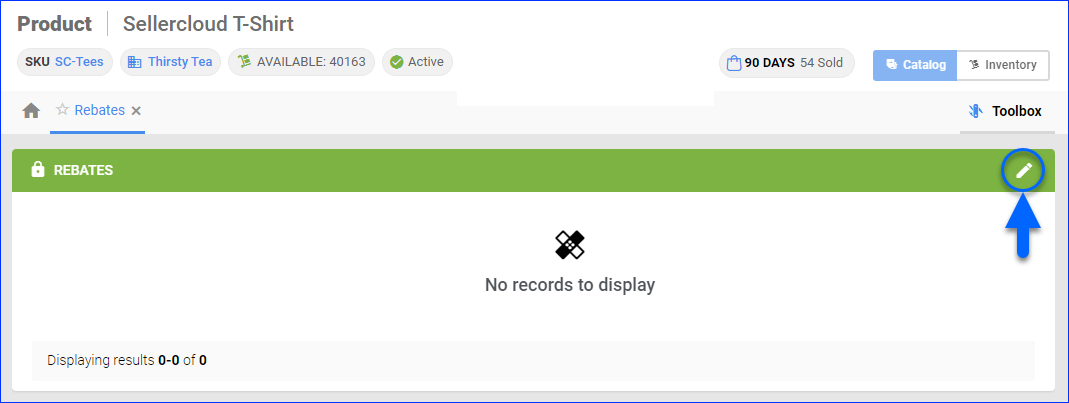
- Click the Add New Rebate button.

- (Required) In the Rebate field, enter the amount by which to reduce the product’s price on integrated channels. When you save the rebate, the Product Cost (based on Client Setting Order Profit & Loss Calculated Using) and Item Cost After Update fields will auto-populate accordingly.
The Rebate Amount will be deducted from the current product cost and the RebatePostingService will revise the sale price on all channels like a regular discount. The rebate will not change the Site Price of a product, so orders created manually will not reflect the rebate automatically. In these cases, the rebate can be entered as a discount to the order.
- (Optional) In the Deduct From Item Cost field, enter the rebate amount the vendor is offering you, if applicable. You can change the Cost Type to be a dollar value or a percentage of the item cost. This amount will be deducted from the product’s Site Cost when calculating the order’s profit & loss.
You can also configure Vendor-Specific Rebates. They apply to all products from a specific vendor and override the product-level vendor rebates you can create with this setting.
- (Required) Enter the Start Date and End Date for both rebates: the one you are offering your customers and the one you are receiving from the vendor. The End Date is the specified date starting at 12:00 AM, not its conclusion at 11:59 PM.
- (Recommended) Check the Is Active box to enable the rebate.
- Based on your preference, use these additional options:
- URL – Enter a URL associated with the rebate for internal reference.
- Apply On Amazon Business Prices – Apply the rebate to the product’s Amazon Business Prices.
- Click Save Rebate. The rebate appears in the Rebates panel.
In Bulk
Importing product rebates allows you to:
- Add multiple new rebates at once
- Update the already existing rebates on your products
To add or update multiple rebates:
- Go to Catalog > Tools > Import Product Info.
- Select Import Product Rebates.
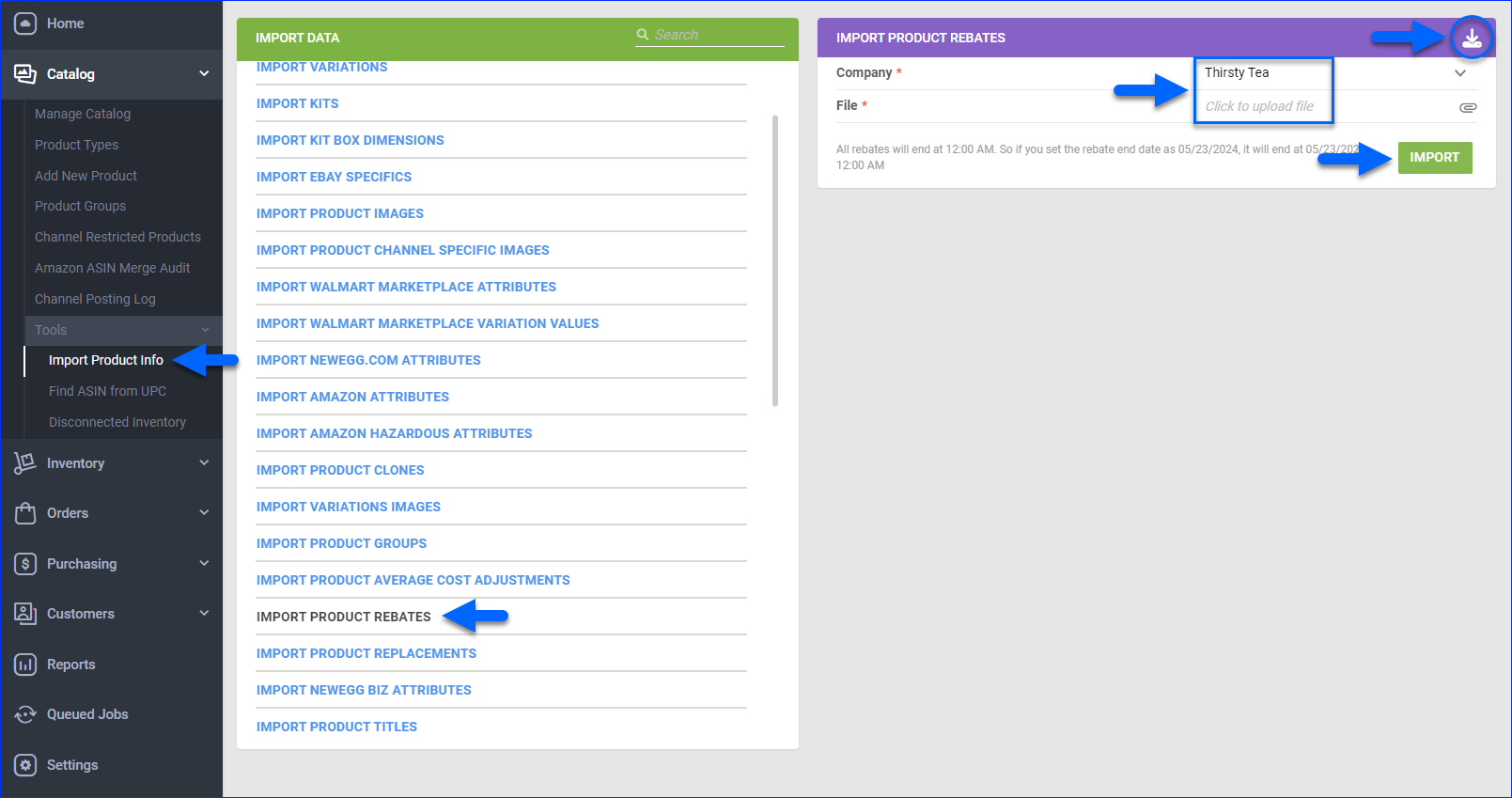
- If you are:
- Importing new rebates from scratch – Click the Download button in the Import Product Rebates panel and select a file type to download a sample template.
- Updating existing rebates – See how to Export Rebates to a spreadsheet so you can change the values in it and then import it to update the rebates.
- The template file’s column headers match the fields on the Rebates page.
When you download the template from the Import Product Rebates panel, the file includes two special rows. The second row in the spreadsheet defines the parameter, and the third one indicates whether the field is required or not. Once you populate all fields, delete these two rows before you save the file.
- RebateID – Required only if you want to update an existing rebate.
- ProductID – Required; the product’s SKU.
- Rebate Amount – Required; the amount by which you reduce the product’s price on integrated channels.
- DeductFromItemCost – Not required; the rebate amount the vendor is offering you. This amount will be deducted from the product’s Site Cost when calculating the order’s Profit & Loss.
You can also configure Vendor-Specific Rebates. They apply to all products from a specific vendor and override the product-level vendor rebates you can create with the DeductFromItemCost column.
- DeductFromItemCostType – Not required; enter % or $ to set the vendor rebate as a percentage value or a fixed amount. The default is $ for a fixed amount.
- FinalPriceToFeed – Not required; enter True or False.
- RebateStartDate – Required; the start date of both rebates.
- RebateEndDate – Required; the end date of both rebates. Note that this is the start of the specified date at 12:00 AM, not its conclusion at 11:59 PM.
- IsActive – Recommended; Enter True or False to enable or disable the rebate; the default is False.
- RebateURL – Not required; an associated URL for internal reference.
- EnablePriceGrabberFeed – Not required; obsolete column.
- ACTION – Type _DELETE_ to delete a rebate. Make sure to enter the RebateID in the same row.
- Return to Import Product Rebates, select the appropriate file, and click the Import button.
Apply Rebates Manually
You can apply product rebates to orders manually, allowing you to add missed or past rebates.
You can apply rebates to orders individually or in bulk.
Individually
To apply rebates to a single order:
- Go to the Order Details Page.
- Click Actions and select Re-Apply Product Rebate.
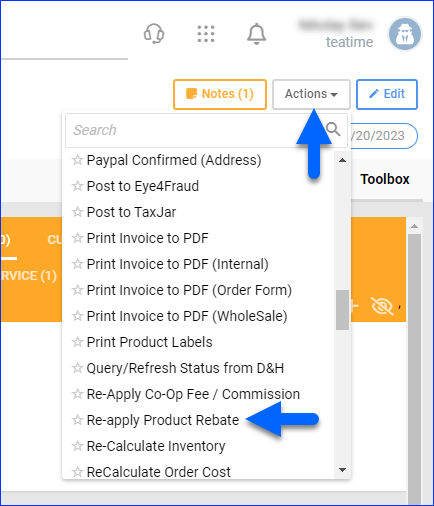
In Bulk
To apply rebates to multiple orders:
- Go to Orders > Manage Orders.
- Find the orders you want to update and select them.
- Click the blue Actions icon at the bottom right and select Re-Apply Product Rebate.

- This action creates a Queued Job. Once the job is completed, your rebates will be applied to the selected orders.
Export Rebates
Exporting rebates is a great way to set yourself up to be able to quickly update multiple existing rebates. By exporting, you generate a spreadsheet with columns following the same format required for a Bulk Import.
To export rebates:
- Go to Catalog > Manage Catalog.
- Search and then select products by checking the boxes on the left.
- Click the blue Actions icon at the bottom right and select Export Rebates.
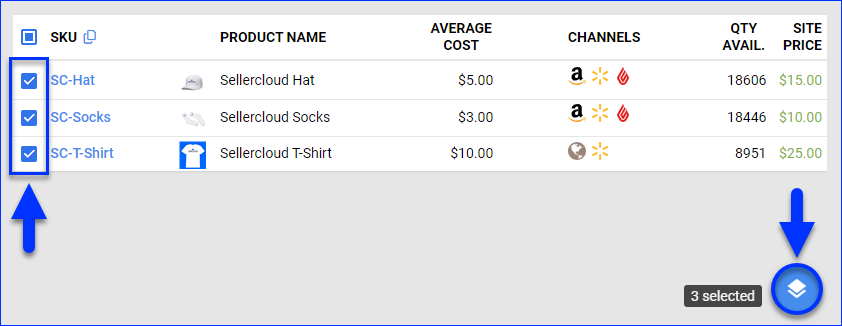
Vendor-Specific Rebates
You can apply a percentage-based rebate to a specific vendor to reduce the cost of all of their products for a specific time period. This is reflected in the Order Profit and Loss.
To add a vendor rebate:
- Go to Purchasing > Vendors > Manage Vendors.
- Search for vendors and click a vendor’s ID or Name.
- Click Toolbox and select Rebates.
- Click the Edit button at the top right of the Rebates panel.
- Click the Add New Rebate button.
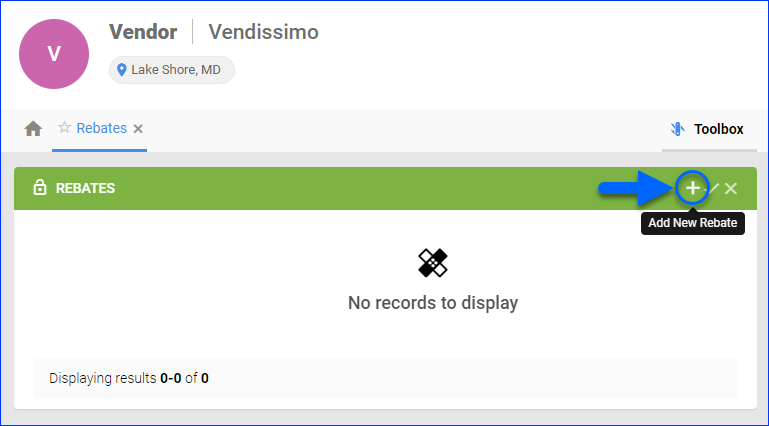
- Check the box to the left to select the rebate.
- Enter the Rebate percentage amount.
- Enter the Start Date and End Date.
- Make sure Is Active is checked.
- Click the Save button. The rebate appears in the Rebates panel.

Related Client Settings
The following Client Settings control how product rebates affect pricing as well as profit and loss calculations.
Enable or Disable Rebates
- Enable Rebate Based Discounts For Channels – Product prices on integrated channels will be reduced by the rebate amount.
- Enable Vendor Based Rebates – Enable the ability to create and manage Vendor Rebates.
- Do Not Post Rebates on Magento via Rebate Service – Disable rebates for Magento products.
Rebate Application
- Consider Item Cost Rebates for Wholesale Customers – Apply rebates to Wholesale Orders. By default, they only apply to retail customers.
- Apply Rebates of Parent to Shadows – Apply product rebates to Shadow Products.
- Include Rebate in P&L for Orders – Include cost-based rebates in the Order P&L calculation. With this setting enabled, you can also enable the setting below.
- Include Rebate from Kit Parent – Apply rebates set on Kit Product parents to their associated components. If one of the components has a rebate as well, the parent’s rebate will apply instead.
Overview
Product Rebates are financial incentives offered by sellers that can be used as a discount to a customer or as a reduction of the product cost when purchasing from a vendor. Thus, by effectively lowering the net cost, the rebate makes the product more attractive to potential buyers.
In Sellercloud, you can apply:
- Price-Based Rebates: Reduce Product Prices on integrated channels. This type of rebate changes the product’s price on integrated channels. The price sent to the channel will be the standard price for the channel minus the rebate amount.
- For example, if the Amazon Price is $99, and you have a price-based Rebate of $10, Sellercloud will update the product’s price on Amazon to $89.
- Cost-Based Rebates: Reduce the product costs in your Order Profit and Loss by a fixed amount or a percentage of the product’s Site Cost. You can apply cost-based rebates per product or per vendor. These rebates are reflected in the orders’ Profit & Loss tab:
- Profit and Loss (Estimated) panel: Rebates and Order Cost
- Order Profit Detail panel: Final Cost, Profit, and Profit %
Prerequisites
To be able to use the rebates functionality, enable these Client Settings:
- Enable Rebate Based Discounts For Channels – Enable price-based rebates for products on integrated channels.
- Include Rebate in P&L for Orders – Include cost-based rebates in the Order P&L calculation. With this setting enabled, you can also enable the setting below.
- Enable Vendor Based Rebates – Enable creating and managing Vendor Rebates.
Walmart Marketplace also requires the setting Enable Rebate Based Prices Upload on the Walmart General Settings to be enabled.
Configure Product-Specific Rebates
You can add both price and cost-based rebates individually or in bulk.
Price-based rebates are currently supported only for these channels:
- Amazon
- eBay
- Magento
- Newegg
- Sears
- Shopify
- Walmart Marketplace
As for cost-based rebates, after you create one, any orders created within the time range of the rebate period will have their P&L adjusted based on the rebate, and an order note “Applied rebate with ID X for amount Y for SKU Z” will be posted. In the note, X is the unique identifier of the rebate, Y is the total rebate amount applied to the order, and Z is the SKU.
Individually
To add a product rebate:
- Go to Inventory > Product > Toolbox > Rebates.
- In the Rebate Amount field, enter the rebate amount you are offering to the customer. The
rebate will deduct from the current price and revise the sale price on all
channels like a regular discount. However, the rebate will not change the site price in
Sellercloud, so orders created manually will not reflect the rebate
automatically. The rebate can be entered as a discount to the order. - In the Deduct from Item
Cost field, enter the rebate amount the vendor is offering you. It could
be a dollar value or percentage of the item cost. - Start and End dates are required. It’s important to
note that the end date refers to the beginning of the specified end date at
12:00 AM, not at the conclusion of the end date at 11:59 PM. The date range will be applied to the
rebate you are offering the customer, and to the rebate you are receiving from
the vendor.
In Bulk
Rebates can also be set in bulk:
- Inventory > Import Product Info > Import Product Rebates.
- Download the sample template. The template includes column headers
referencing all fields on the Rebates page. The next two rows define the column header
and indicate the required columns. After entering the rebate information, delete
these two rows before saving the template. - Select your rebate file and click Import Rebates to update the products.
Rebates can also be created through Sellercloud’s web services. If you generate rebates through a software
application, you can use Sellercloud’s API to import the rebates into Sellercloud.
Rebates are included in these Transaction reports:
- Profit by Product Summary
- Profit By Product Details
- Profit by Order Details
- Transaction Details by Date
Related Client Settings
The following Client Settings control how product rebates affect pricing as well as profit and loss calculations.
Enable or Disable Rebates
- Enable Rebate Based Discounts For Channels – Product prices on integrated channels will be reduced by the rebate amount.
- Enable Vendor Based Rebates – Enable the ability to create and manage Vendor Rebates.
- Do Not Post Rebates on Magento via Rebate Service – Disable rebates for Magento products.
Rebate Application
- Consider Item Cost Rebates for Wholesale Customers – Apply rebates to Wholesale Orders. By default, they only apply to retail customers.
- Apply Rebates of Parent to Shadows – Apply product rebates to Shadow Products.
- Include Rebate in P&L for Orders – Include cost-based rebates in the Order P&L calculation. With this setting enabled, you can also enable the setting below.
- Include Rebate from Kit Parent – Apply rebates set on Kit Product parents to their associated components. If one of the components has a rebate as well, the parent’s rebate will apply instead.
